IT Outsourcing: How To Choose The Right Partner?

Have you ever wondered what is more difficult, having an idea or bringing it to life? The idea cannot bring success, just like implementation won’t work without a brilliant idea. In short, those are nuts and bolts that need to work together. To make them work, you will need a “partner in crime.”
The question is, “How to find a team you will realize your idea?”
Hiring an in-house development team is one of the options, but only if you are ready to deal with the hiring process and all related bureaucratic problems.
IT outsourcing is a common practice that is extremely popular both among small and enterprise businesses. Regardless of your company size, you can benefit from product development outsourcing.
The global market of IT outsourcing services valued at $395 billion in 2022 is projected to grow at an 8,26% CAGR rate from 2022 to 2027 and reach $587.3 billion in 2027.
It’s an extremely fast-growing industry that allows you to get access to a global talent pool regardless of your location.
This comprehensive guide on IT outsourcing explains how to outsource software development to leverage the best benefits.
Here’s a quick outline of the valuable information inside:
- What is information technology outsourcing?
- 9 steps of IT outsourcing (all steps explained in detail)
- Best locations with IT outsourcing services
This guide is for you if you’re ready to go “all in” with IT outsourcing.
Let’s dive right in.
What Is IT Outsourcing?
IT outsourcing is the business practice of engaging external providers to handle tasks related to information technology, such as software development, app development, support, marketing processes, etc.
Companies outsource tasks for several reasons, such as access to the best talents, unlimited scalability, and higher service quality. But in most cases, the decision is brought down to a better price and quality ratio.
According to the Deloitte Global Outsourcing Survey 2023, 70% of companies turn to IT outsourcing because of cost reduction. The second main reason among 40% of companies is flexibility. The third reason with 20% of support is faster speed to market.
Cost reduction is the main factor that drives the client’s decision to turn to information technology outsourcing.
So, how can you outsource software development?
The process consists of ten main steps:
- Deciding why you need IT outsourcing
- Deciding which IT outsourcing services you need
- Evaluating outsourcing pros and cons
- Understanding key outsourcing models
- Exploring key cooperation types
- Getting a grip on IT outsourcing pricing models
- Exploring locations with the best IT outsourcing companies
- Shortlisting potential IT companies
- Identifying criteria for selecting a reliable vendor
- Choosing the best vendor:
Let’s take a detailed review of each IT outsourcing step.
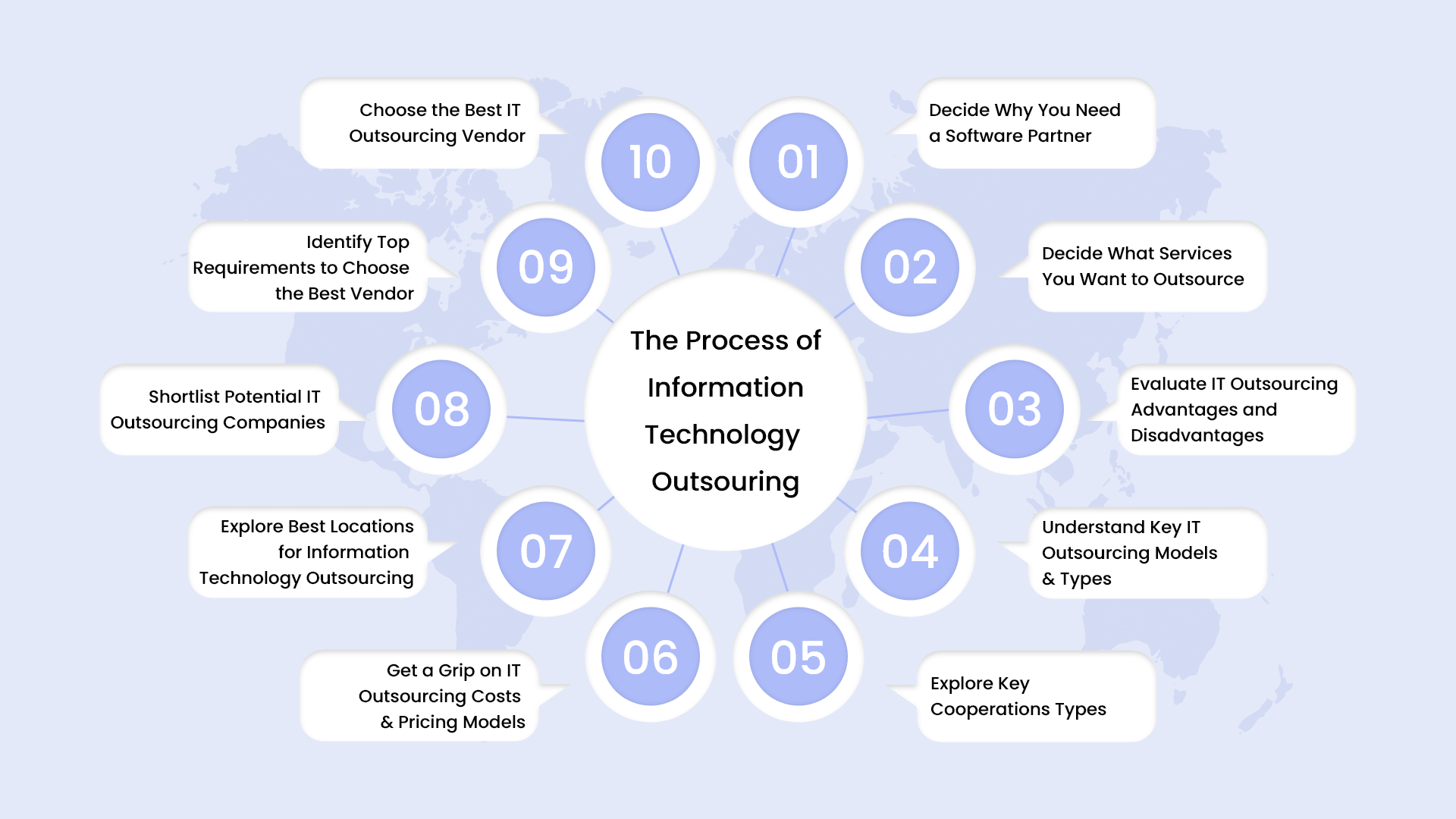
Step 1: Decide Why You Need a Software Partner
Before looking for an information technology outsourcing company, decide why you need a software partner. Usually, there are certain reasons why companies choose to turn to IT outsourcing:
- You are an expert in your industry and have an idea for a digital product to solve some users’ problems. In this case, you might need to deliver the solution to the market and test it as soon as possible. An IT outsourcing services company will help you quickly build a solution and test it without spending time hiring an in-house team.
- You are an early-stage startup and want to reduce the development cost. You won’t need to hire a whole team of designers, developers, QA engineers, and other professionals to bring your idea to the market. IT outsourcing will help you save time and money while delivering the product to the market faster.
- You lack some technical expertise in your in-house team and don’t want to deal with hiring it right now. IT outsourcing may cover different services, UX/UI design, development, quality assurance, etc.
- Onboarding new staff is too time-consuming; you can’t afford any time delays in development and need to deliver the solution to the market as soon as possible.
If your needs meet some of the factors mentioned above, there is a good chance that your company will benefit from IT outsourcing services
IT Outsourcing or a Hired Professional: Which Is Better?
You might be wondering why outsource software development if you can hire an internal team. Let’s clear some air and identify the pros and cons of hiring an internal development team.
So, the main benefits of an in-house development team are:
- Higher engagement of the team in internal business processes
- Full control over the development process
- Instant access to your team
But the coin always has two sides, and working with an in-house team also has some disadvantages:
- Hiring an in-house development team is always more expensive; you need to pay for office space and equipment aside from paying salaries.
- With an in-house team, you won’t have the flexibility of IT outsourcing, so your capabilities will be limited to the talent you hire.
- After the main stage of the project is over, your team might not have enough tasks on hand. However, you will still need to pay them the full salary.
- Hiring a team is one task; employee retention might be a real struggle in the highly competitive IT market.
Step 2: Decide What Services You Want to Outsource
Today, you can efficiently outsource almost any task, including
- Accounting
- Marketing
- Sales
- Customer services
- Shipping and logistics
- Manufacturing
- IT management
- Development
In the case of IT outsourcing, we’re talking about the outsourcing of:
- Business analysis
- UX and UI design
- Project management
- Quality assurance
- Front-end and back-end development
- iOS and Android development
- Flutter development
- Software support
Before looking for an information technology outsourcing vendor, you need to understand which services you want to outsource fully.
Step 3: Evaluate IT Outsourcing Advantages and Disadvantages
Just like any other service in the world, IT outsourcing has two sides. In this chapter, we’ll evaluate the pros and cons with the goal of better understanding how your company can leverage it to the fullest.
10 Information Technology Outsourcing Pros
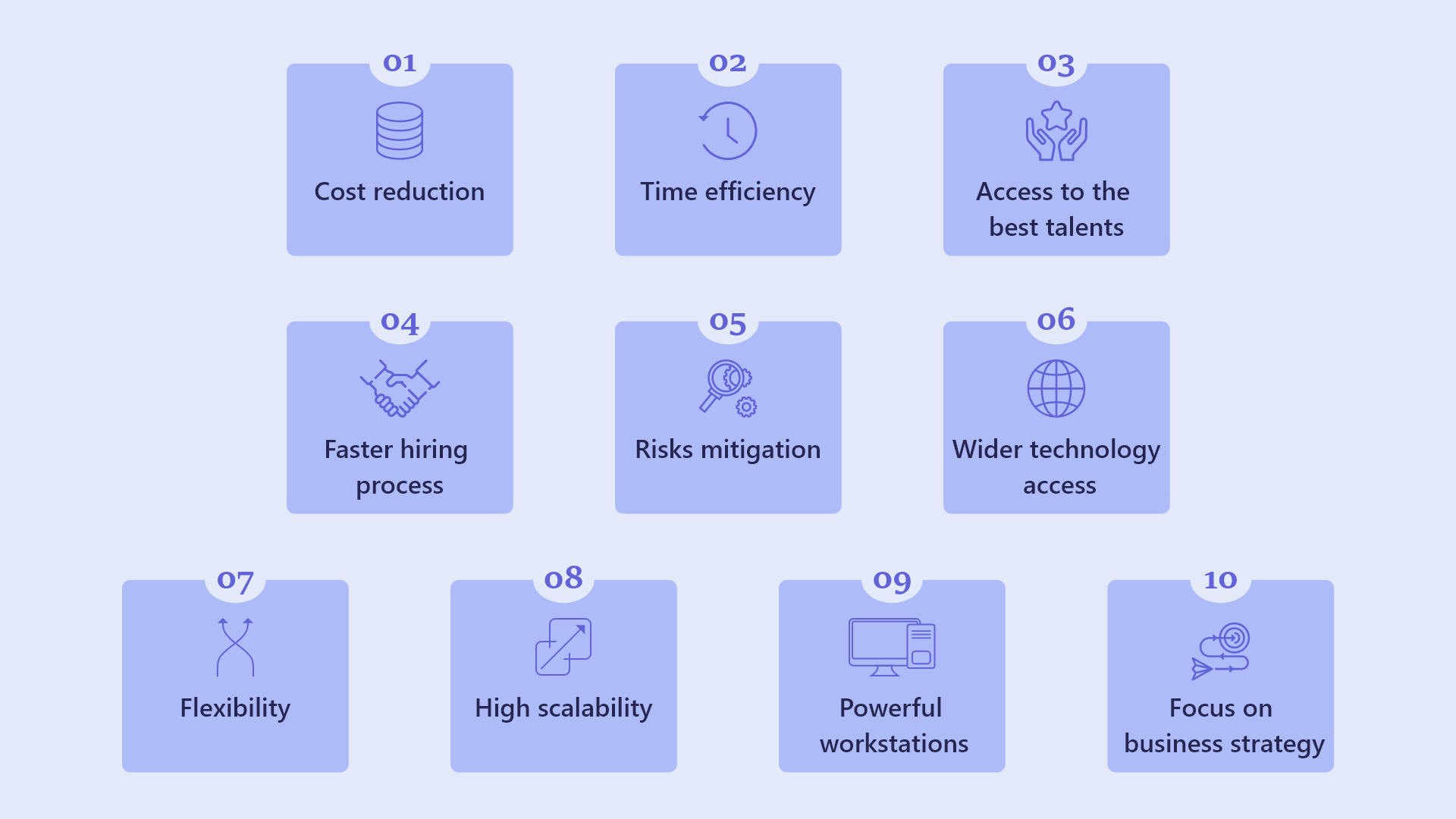
The reasons why companies decide to outsource are numerous. As mentioned before, they turn to such services because of reduced cost, higher flexibility, and faster time to market. But the benefits are much more diverse. Let’s review all of them.
- Cost reduction
Keeping the labor costs low is the first and foremost reason companies decide to hire an external team instead of an internal one. Since a business doesn’t need to hire and retain a development team, the costs are significantly lower as you don’t need to pay salaries, taxes, sick leaves, etc. In fact, IT outsourcing can cut development costs by up to 30%.
You can allocate the money you save on development to other tasks to improve internal processes or expand the in-house team of professionals.
- Time efficiency
IT outsourcing is all about providing you with the needed experts and getting down to work as soon as possible. By entrusting the work into the hands of the experts and hiring a project manager to control all the processes, you get the job done faster and off-load tasks from the internal team. For example, if you hire a project manager, you won’t need to spend time managing the development team. You will be able to dedicate the time to other business tasks.
If you work with a company from a different time zone, you can set up around-the-clock work. You set up a task in the evening, and it will be done even before you wake up in the morning.
- Access to the best talents
Finding great professionals is challenging, especially when talking about the most sought-after talents. In some cases, you might not find them at the local market, and you would need to expand the search area.
IT outsourcing allows you to quickly address such situations without spending countless hours hunting down the required experts, negotiating with them, and trying to get them on your team. You can get in touch with a company providing IT outsourcing services, state your requirements, and they will provide you with the talents you need.
- Faster hiring process
If you’ve ever tried hiring an employee, you probably know it’s a challenging task. IT outsourcing can solve the problem for you. It’s much easier to find a vendor that will provide you with the needed skills set than hunting down the required talent and trying to lure some talent from their current employee.
- Risks mitigation
IT outsourcing comes along with the possibility of risk mitigation. Working with an IT vendor, you won’t need to deal with situations when your key team member decides to quit the job in the middle of the project. If such a situation occurs, the vendor will replace the expert so that the work process won’t be interrupted.
- Wider technology access
Keeping up with the latest technologies on the market is challenging. An in-house team might not be able to do the work and study the latest technologies. Thus, you would need to refrain from implementing new technologies just because you don’t have the required specialists.
That’s where IT outsourcing comes in handy, as you can get access to the latest solutions for your projects.
- Flexibility
IT outsourcing provides businesses with a higher level of flexibility. If you need to add some new tech stack, the vendor will probably have the required expertise. If they don’t, it’s much easier to find a new vendor than to find a full-time employee to work on your project.
- High scalability
When you create an app, you might quickly need to create an app version for another platform, iOS or Android. In such a case, you need to search for the required talent and hire in-house professionals, which is a tedious task that is not done in a single day.
An information technology outsourcing company will be able to scale your team in a few days, if not hours. Such companies usually have a vast pool of talents that can jump right into the development process.
- Powerful workstations
Working with an in-house team comes with additional expenses on buying equipment and keeping it up to date. You will need to spend hundreds of thousands on the equipment, or you can pay for IT outsourcing services and let the vendor deal with all such problems.
- Better focus on business strategy
Managing an internal team of developers is a task that requires a lot of time. A business can allocate this time to other tasks, such as working on business strategy and research. IT outsourcing allows you to dedicate more time to the most critical business operations while entrusting product development into the hands of experienced developers.
5 IT Outsourcing Cons
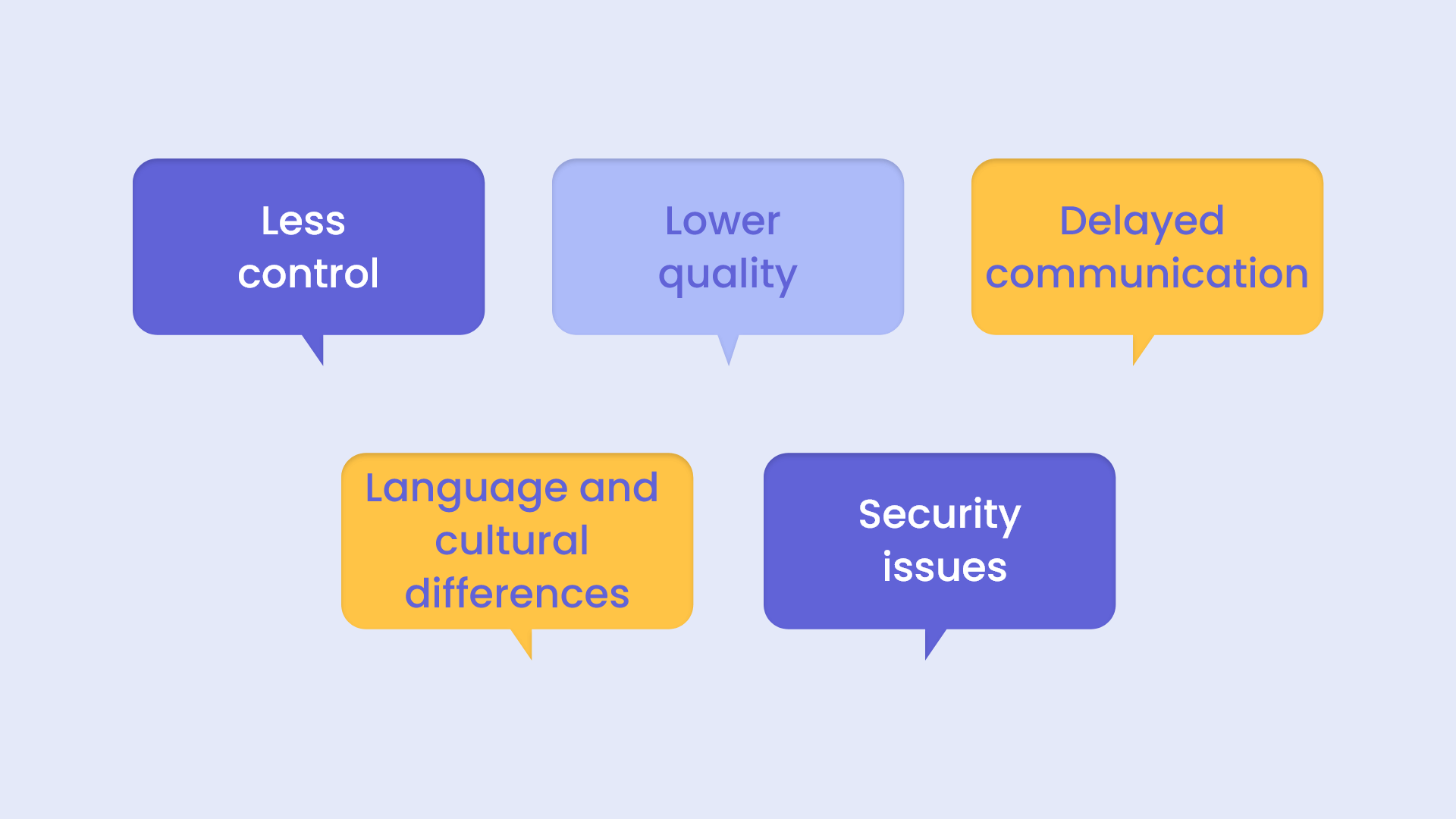
Nothing is perfect as it may seem at first sight and even outsourcing with so many obvious benefits have some drawbacks. Let’s review some cons of IT outsourcing that might stand in the way of making the decision.
- Less control
One factor that stops companies from investing in information technology outsourcing services is the lack of control over operations. Some businesses are afraid that hiring a third party won’t deliver the required results and quality. Some can’t go on apprehending that another company takes care of the product’s security and performance. One day, you might even think you may lose control over the situation.
How to solve the problem: misunderstandings between a business and a vendor often occur because companies don’t communicate their expectations and needs. One of the ways to address this problem is to set up regular meetings with your outsourcing team to keep up with everything happening in your project and communicate all processes beforehand. You can even have an in-house project manager who’ll control all the operations on your side.
- Lower quality
When looking for a vendor, many businesses are lured by a smaller price and hire a company that cannot deliver the required results. That’s one of the reasons why businesses are hesitant to explore IT outsourcing services.
How to solve the problem: hunting for the lowest price might not be a good idea if you care about the quality of provided services. Hire a team with only a proven track record and review feedback from former and current clients before making any decisions.
- Delayed communication
Working with a contractor may backfire when facing some security issues or facing downtime. Long lapses in communication may lead to extended software downtime and cause serious money and reputational damage.
How to solve the problem: before signing an agreement, ensure that you’ve communicated the possibility of such delays with the vendor and register them on paper. In case of emergencies, you and your tech partner will have a plan of action that will mitigate any risks.
- Language and cultural differences
Deciding to work with an offshore agency from a different country, businesses often face the problem of language, cultural barriers, and different time zones. As a result, such differences can negatively impact communication, the efficiency of your development team, and the future of the whole project.
How to solve the problem: any problem that might arise should be addressed before the project starts. During the first interaction with your future technical partner, you can quickly evaluate the level of English knowledge and any cultural differences that might interfere in the future. It would help if you established the communication rules and how you would exchange your ideas and other information. It’s one of the ways to achieve smooth communication with your partner and avoid any problems.
- Security issues
Choosing a tech partner, businesses also choose a company that will have access to its data and let them handle it. In case of data leaks, a company might even have to answer in court for the actions of its partner. The ever-changing regulations, which might differ in different countries and locations, don’t make the task easier.
How to solve the problem: make sure you understand how your partner protects data from losses and breaches and how it ensures the privacy and anonymity of your users.
As you can see, there are always two sides to each solution. However, you can bring the risks of outsourcing IT services to the minimum by choosing a reliable vendor with a proven track record. You might even want to get in touch with their current and former clients to understand how the company works and whether they had any issues with them. Explore the best countries for software outsourcing.
Step 4: Understand Key IT Outsourcing Models & Types
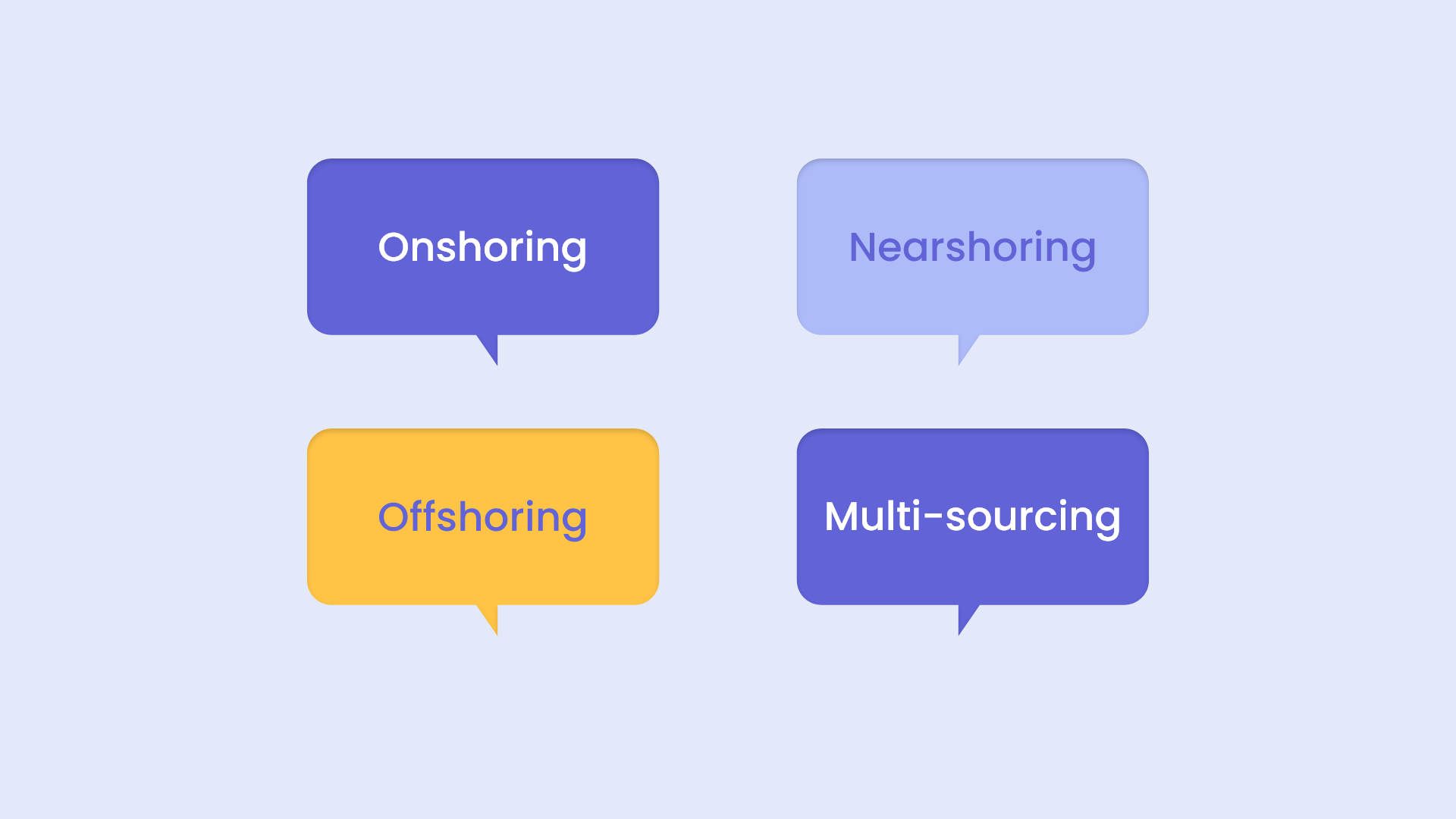
Knowing all the pros and cons of IT outsourcing, businesses need to choose a suitable cooperation model. That’s right. There are a few types of IT outsourcing.
So, what are the types of information technology outsourcing?
There are four main types of IT outsourcing:
- Onshoring
- Nearshoring
- Offshoring
- Multi-sourcing
The physical location of service providers explains the difference between the types. meet your specific business needs.
Onshore IT Outsourcing

Onshoring is also called homeshoring because this IT outsourcing type involves hiring a team outside your company but from the same location.
While this IT outsourcing model has its benefits, such as being in the same time zone as the vendor, it has its shortcomings. The main one is limited capabilities when it comes to cost savings. That's the number one reason why many businesses avoid this IT outsourcing model.
Example: a company located in New York hires an IT company from Taxes.
Nearshore IT Outsourcing
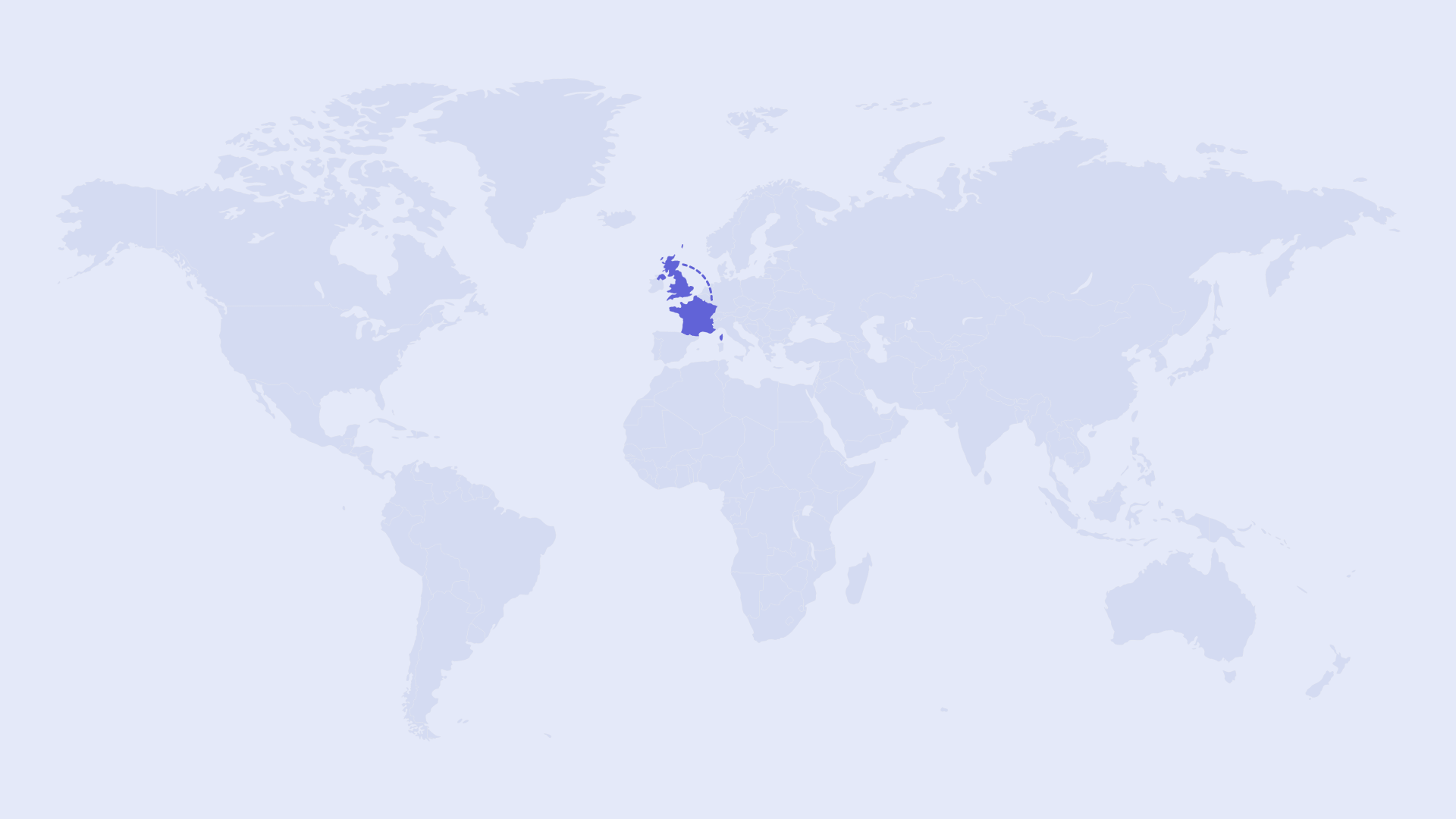
Nearshore outsourcing means hiring an IT outsourcing company from a neighboring country, usually in the same time zone. The main benefit of this option is that you remain in the same time zone with your tech team and can save money by outsourcing to more cost-effective IT outsourcing countries.
Example: a company from the UK hires a vendor from France.
IT Offshore Outsourcing
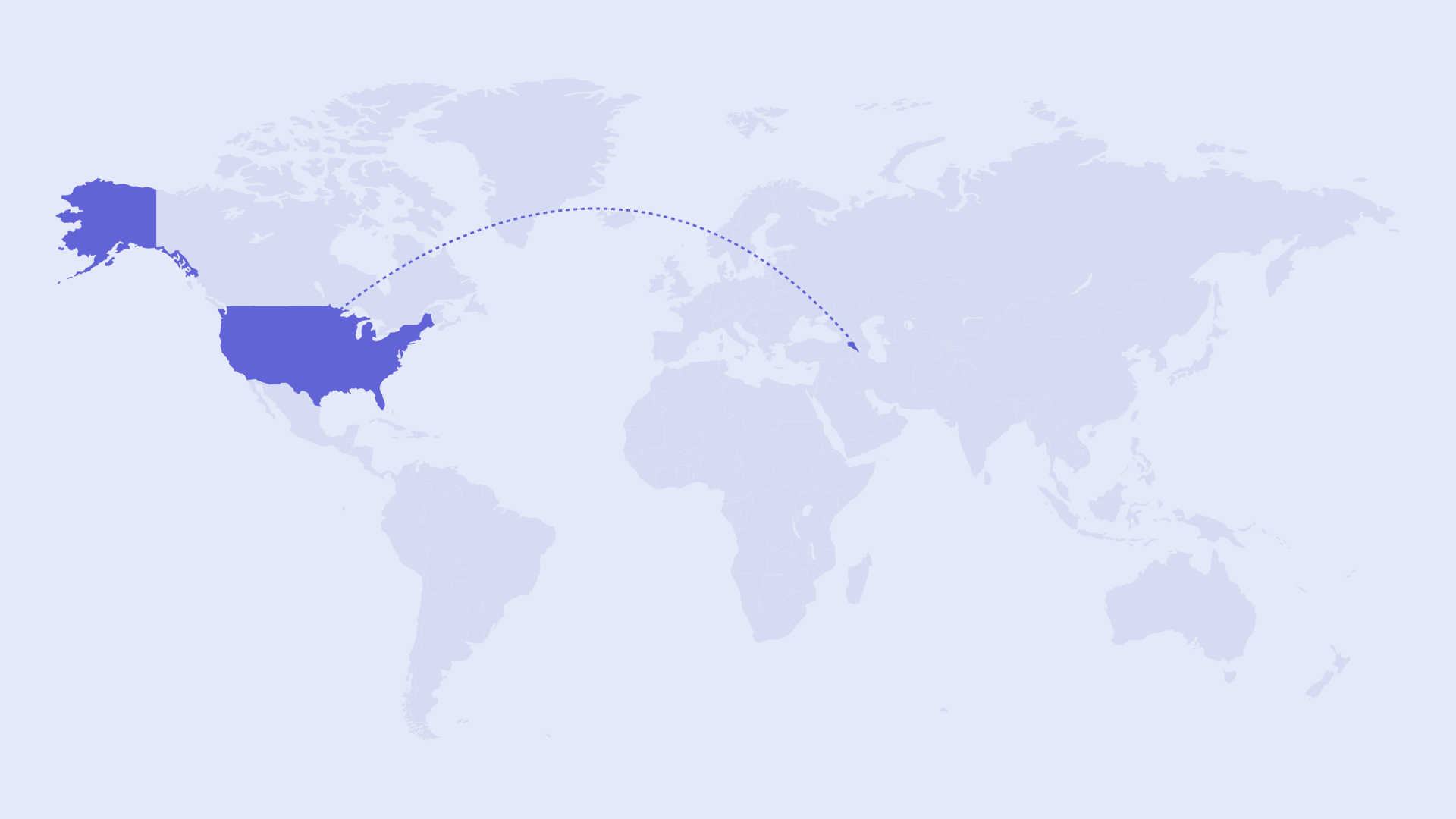
Offshore IT outsourcing entails hiring a tech vendor from a distant location, at least four time zones away from its own company. This is the most popular type of IT outsourcing that allows companies to enjoy more favorable pricing and access a larger talent pool.
Even though working in different time zones might seem challenging, it may play into your hands. For example, if you hire a customer support team, they can work at night while your main team is enjoying their night’s sleep.
Example: a company from the USA hires a technology partner in Armenia.
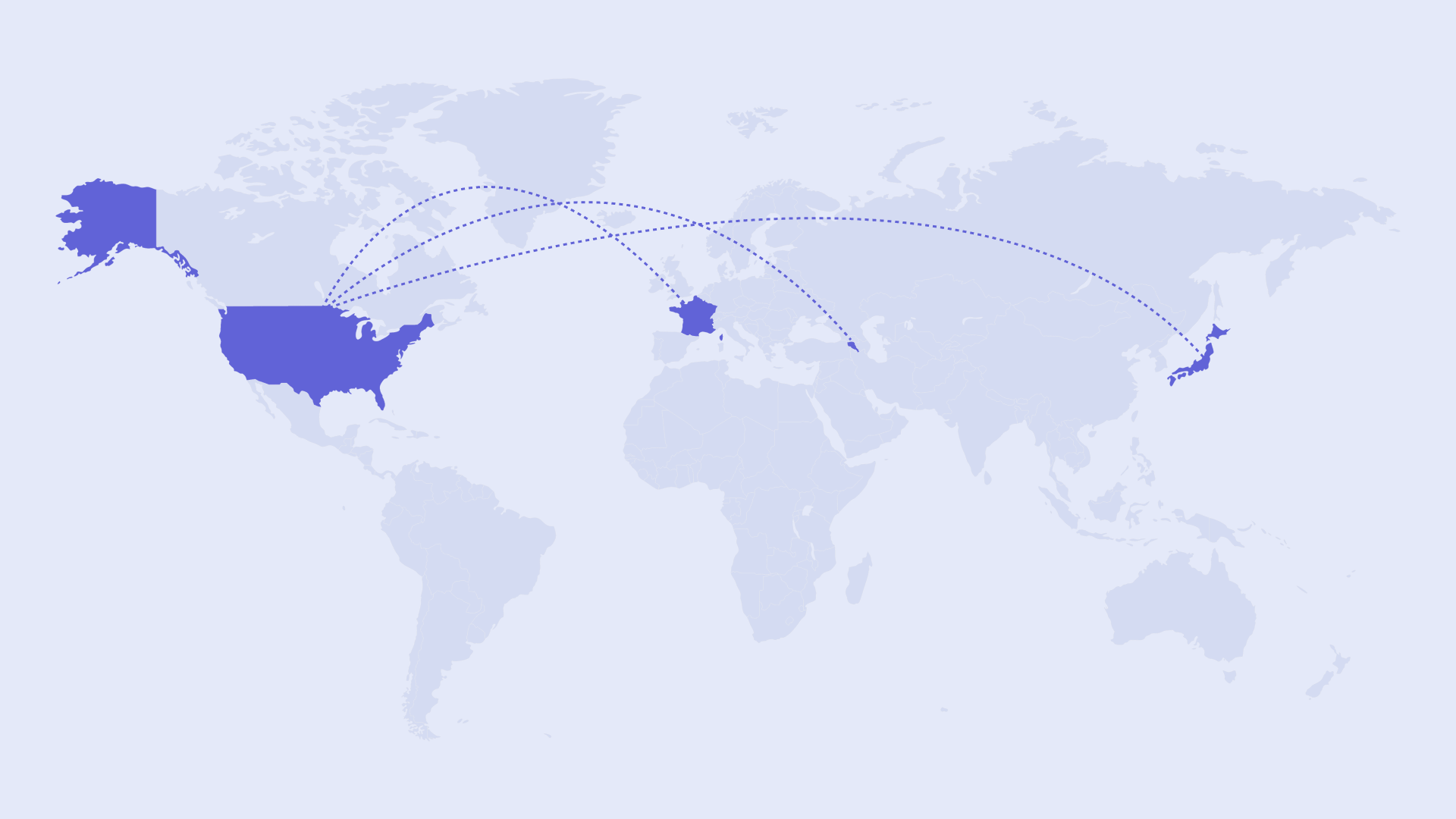
Multisourcing allows you to mitigate risks by hiring a few vendors from different locations to work on your project simultaneously.
Example: a company from the USA hires a customer support team in Germany, a development vendor in France, and a marketing team in Japan.
There are a few IT outsourcing models that you can choose from based on your specific business needs. While some offer faster communication, others provide round-the-clock work and higher cost-efficiency.
It’s up to you to decide which benefit plays a more significant role for you.
Step 5: Explore Key Cooperation Types
Aside from IT outsourcing models based on location, there are 3 types of projects.
- Staff augmentation
- Project-based
- Dedicated development team
Let’s review each of the types
Staff augmentation
Staff augmentation is a lifesaver when a company misses specific talent and expertise in the core team and wants to fill in the gap. Instead of hiring an in-house expert, it’s possible to reach out to a tech vendor and get the needed help from them.
Augmented staff members act as your own employees. At the same time, you don’t need to worry about the hiring process and all the associated bureaucratic aspects.
Use cases: when you lack some talent and don’t want to deal with hiring
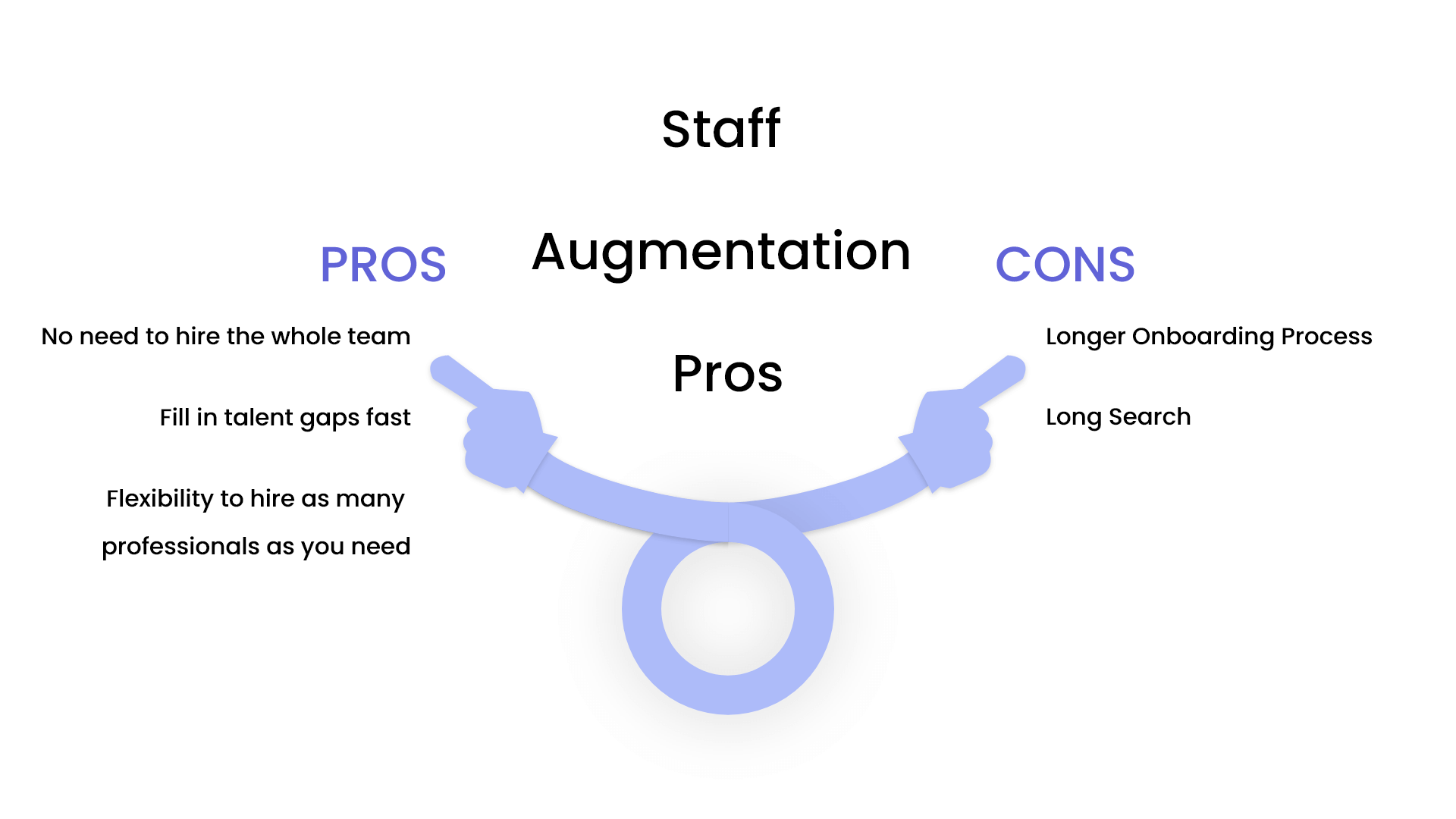
Project-based outsourcing
This model entails hiring a team to implement a part of work or develop a digital product that is already planned and well-defined. The outsourcing company takes on the task, manages all the processes, and delivers the ready-to-use product to its client.
Use cases: small projects with clear requirements and well-defined functionality
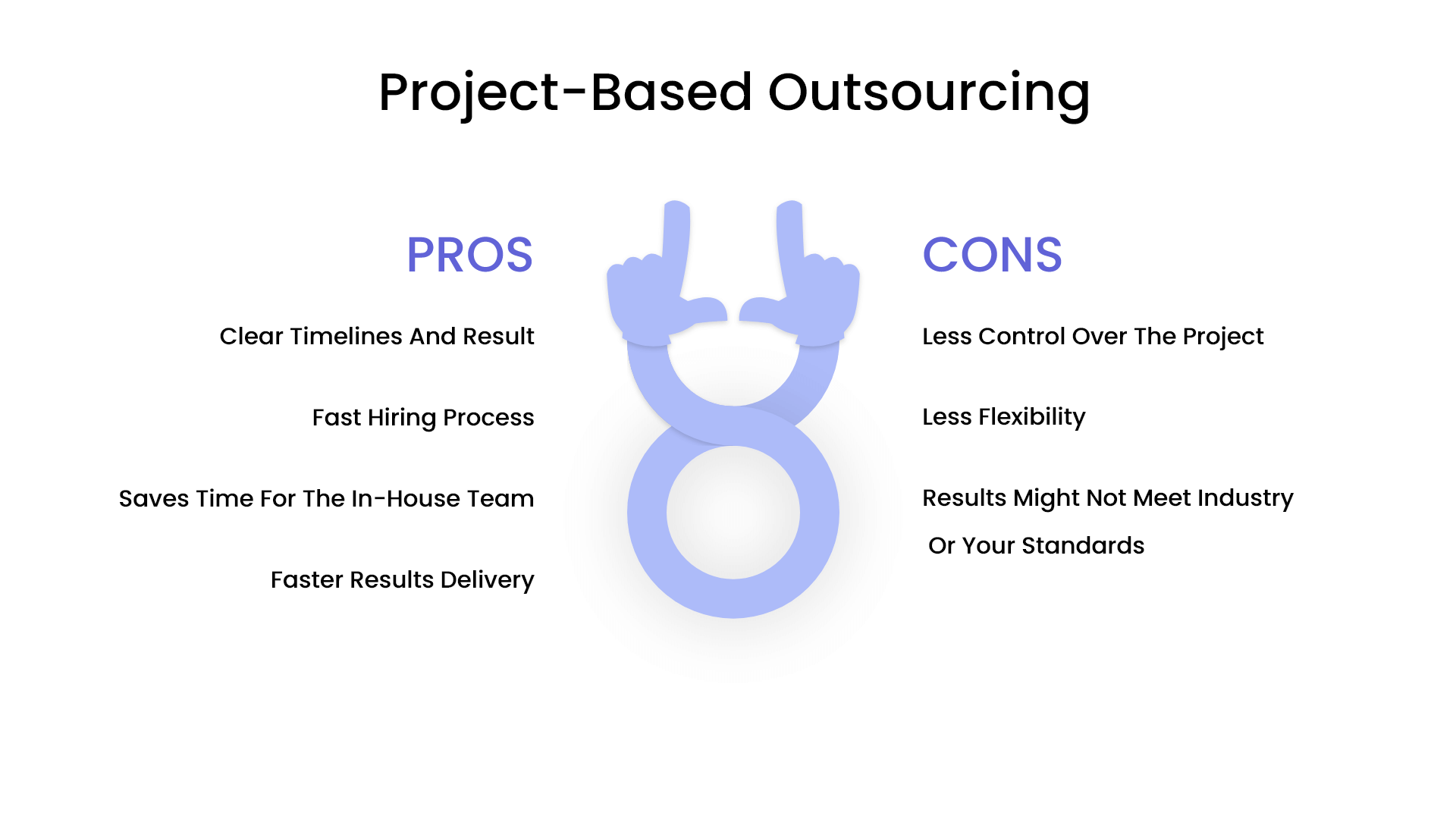
Dedicated development team
This cooperation model is suitable for companies interested in building complex projects with long-term partners. Unlike other models, a dedicated team works on your project full time, which allows you to deliver the needed results faster and provide higher engagement in your project.
Use cases: complex projects that require ongoing support and don’t have precise final specifications
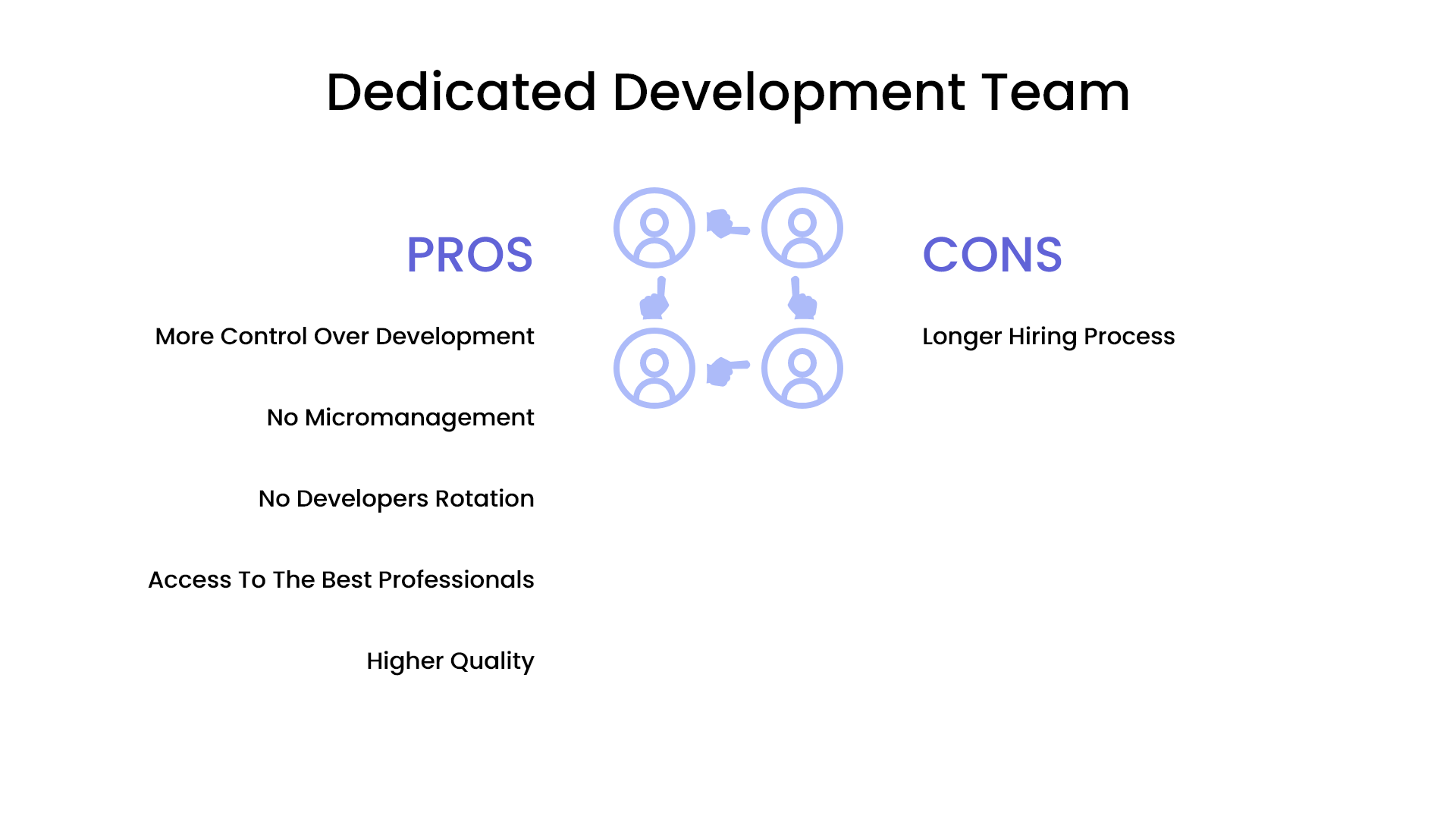
Step 6: Get a Grip on IT Outsourcing Costs & Pricing Models
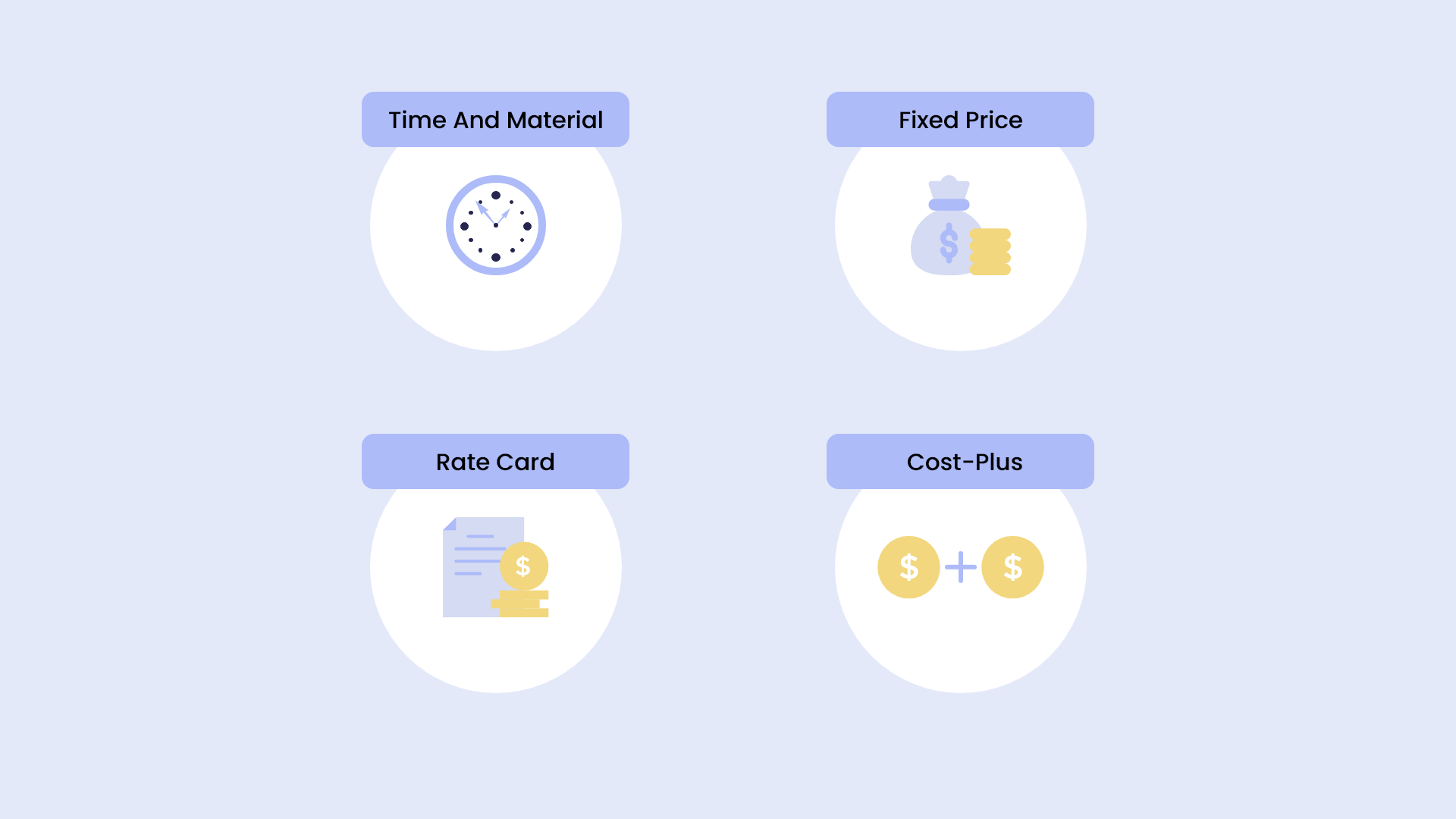
IT outsourcing models overviewed in the previous chapter directly influence the pricing model you’ll have to work with. There are four main pricing models available:
- Time and material
- Fixed price
- Rate card
- Cost-plus
Below is a more detailed overview of each model.
Time and material
Time and material or T&M is quite a popular pricing model in the IT world. Clients only need to pay for developers' hours working on a project based on this model.
Pros: you have complete control over your project. You can change requirements at any time, add or delete features from the work plan, and even shift the whole focus of the project without paying extra.
Cons: you never know how much you will need to pay for the work done. After developers estimate a task, the cost may change if some challenges arise in the process.
Fixed price
As the name entails, a vendor delivers a project within a predefined budget and time. This model applies to projects with clear specifications, as you won’t be able to change any requirements after the project starts. In some cases, it’s possible to make changes, but the client will be charged additionally for every slightest change.
Pros: you know when your project will be delivered and how much you will need to pay for it. Even if the time frame changes because some difficulties arise, you won’t need to pay extra if the requirements and specifications remain unchanged.
Cons: every change you make to the initial work scope will cost you extra. This cooperation model might turn out to be more expensive than T&M, as vendors often add up to thirty percent additional cost to mitigate any risk if something goes sideways during development and their developers need to spend more time on the project.
Rate card
Rate card is a pricing model when you need to pay a monthly rate for developers who work on your project.
Pros: you always know how much you will need to pay each month for development services.
Cons: you have little to no say in deciding who will work on your project.
Cost-Plus
The cost-plus or cost-reimbursable model entails paying a fixed price for the development team and extra costs charged by the vendor. These extra costs may include expenses for workstations, resources that the vendor spends on the hiring process, taxes, etc.
Pros: you always know the monthly payment for development services.
Cons: you never know how much cost-plus you’ll need to pay.
Below you can see a table comparing the main advantages and disadvantages of the pricing models mentioned before.
| Time and materials | Fixed price | Rate card | Cost plus | |
| Flexibility | Yes | No | Yes | Yes |
| Expenses predictability | No | Yes | Yes | Yes |
| Strict timeline | No | Yes | No | No |
| Long-term cooperation | No | No | Yes | Yes |
| Direct communication with dev team | No | No | Yes | Yes |
Step 7: Explore Best Locations for Information Technology Outsourcing
There are a lot of places where you can outsource the development of your digital product. This chapter will review the most popular outsourcing destinations worldwide to help you decide which one will be most suitable for your business.
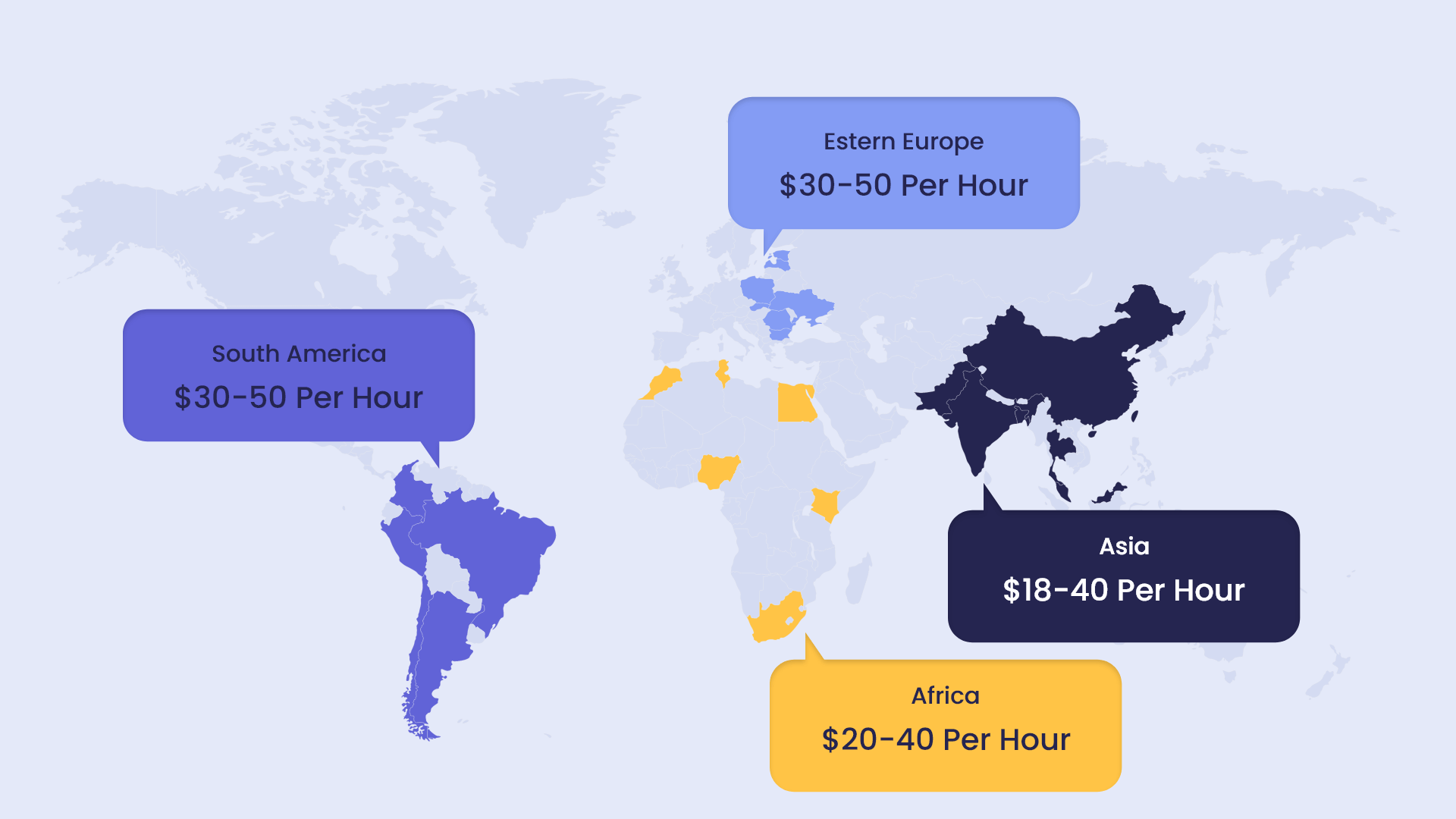
Eastern Europe
Eastern European countries have a long history of information technology outsourcing and provide high-end services. Relatively low development costs and high quality make Eastern Europe an attractive IT outsourcing region for businesses worldwide. You don’t have to sacrifice quality for lower prices.
Low prices combined with favorable taxations, for example, in Ukraine, turn Eastern Europe into a very attractive location.
Best outsourcing locations: Ukraine, Belarus, Armenia, Moldova, Czech Republic, Poland, Romania, Hungary.
Cost: average cost of IT outsourcing services is $30-60 per hour.
Expertise: this is a location with the best skills and expertise. The level of English is also very high.
Popular programming languages: Ruby, Java, Python, PHP, Big data, Blockchain, ML
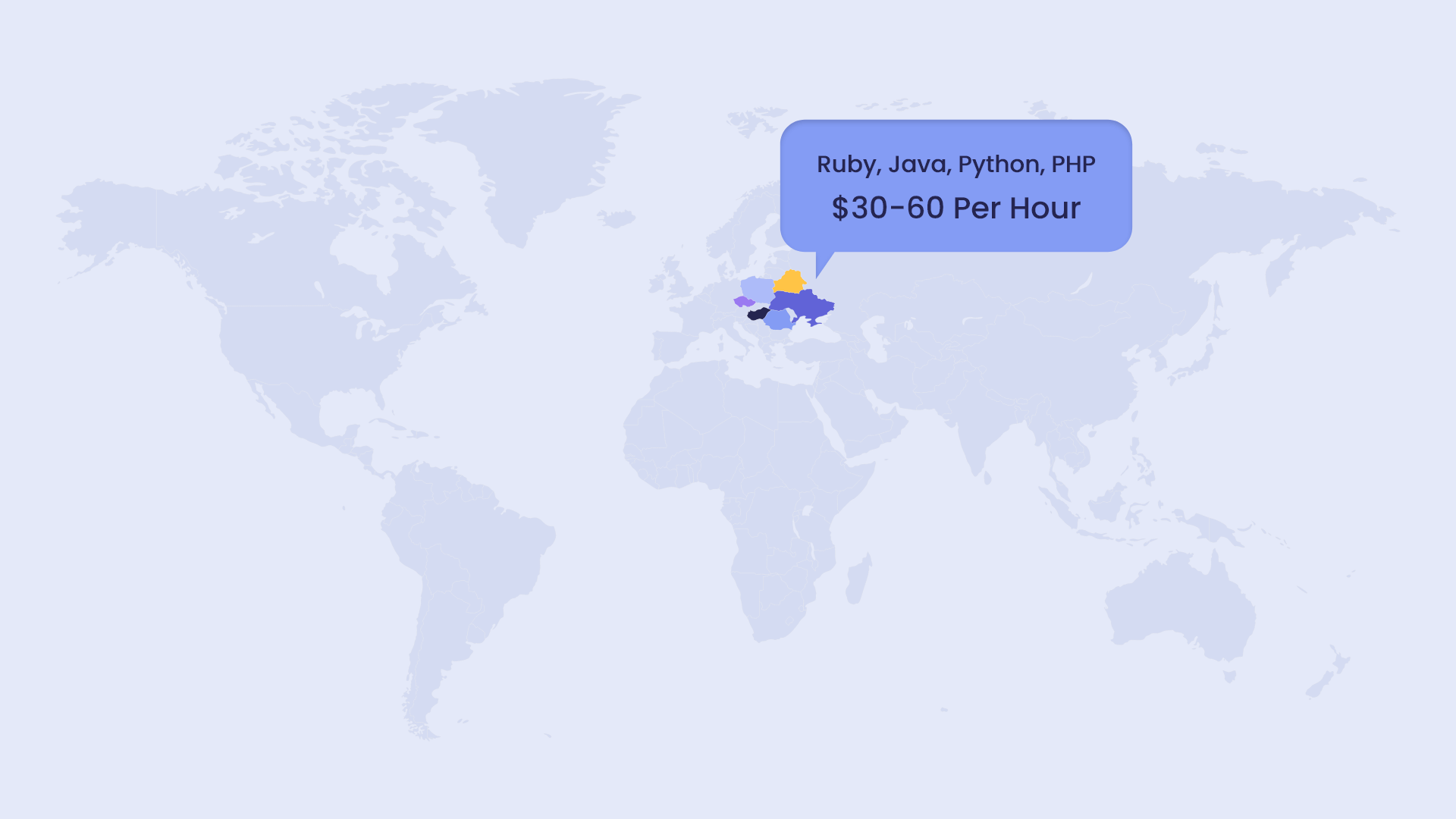
Asia & Middle East
Asia is probably one of the most popular IT outsourcing locations in the world for the cheapest services. India was the pioneer in the area and is known for offering low prices. However, you might not get a satisfactory quality of IT outsourcing services at a lower price if you don’t choose a company carefully. The main concern is cultural differences that can prevent smooth communication with your tech partner.
Best outsourcing locations: India, China, Vietnam, Malaysia, Indonesia, and the Philippines.
Cost: average cost is $15-$40 per hour. The highest prices are $50-$100/hour in China.
Expertise: a satisfactory level of expertise and English knowledge.
Popular programming languages: Java, C++, Python
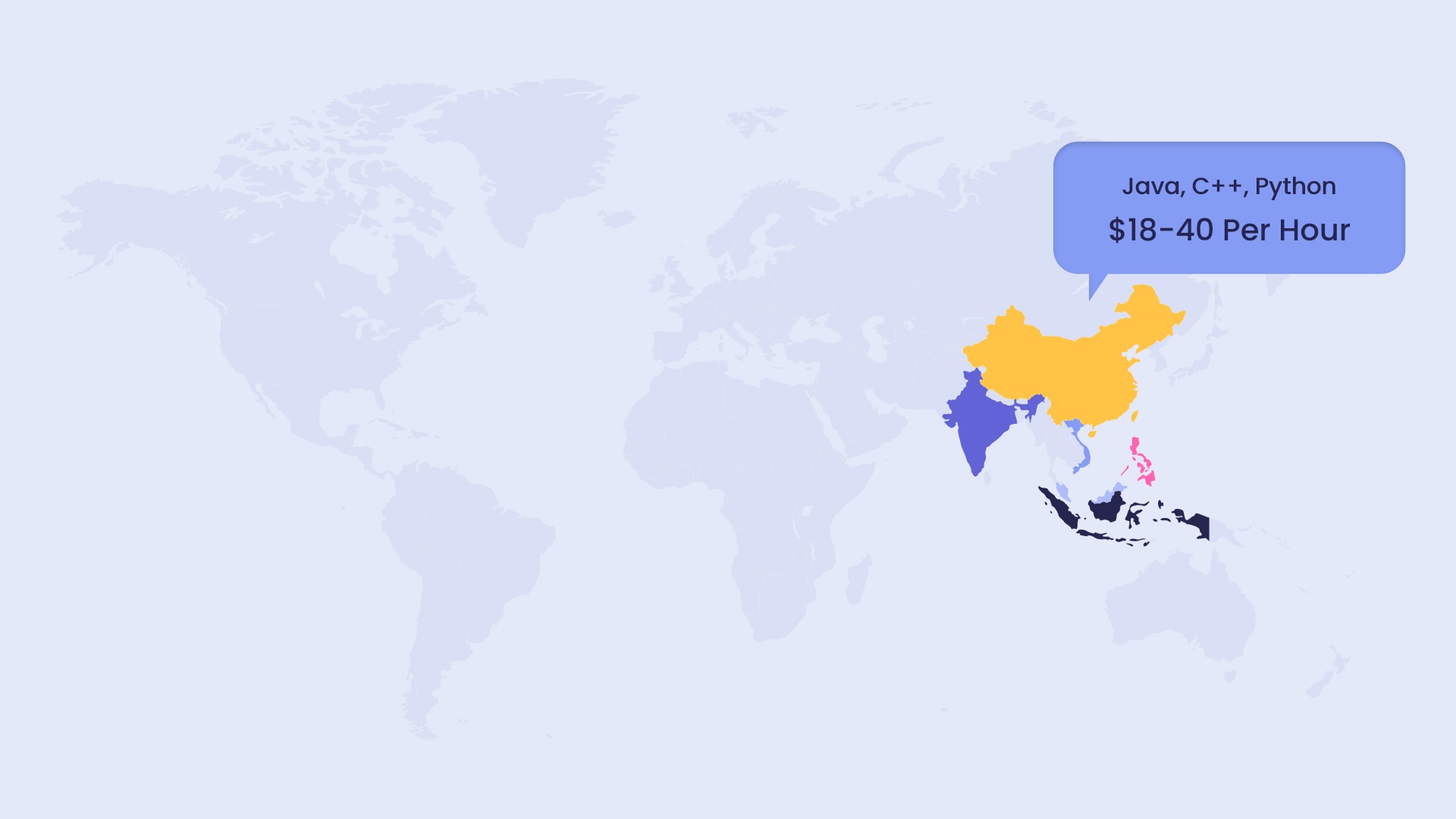
Latin America
Latin America often becomes a target for IT outsourcing among businesses from the USA. Aside from offering a great price and quality ratio, countries from Latin America are in the same time zone as the USA and Canada. Even though South America is a relatively new outsourcing location, it’s gaining popularity quite quickly.
Best outsourcing locations: Brazil, Mexico, Argentina
Cost: $30-$50 per hour
Expertise: junior and middle-level developers, high knowledge of English.
Popular programming languages: Java, Python, SQL
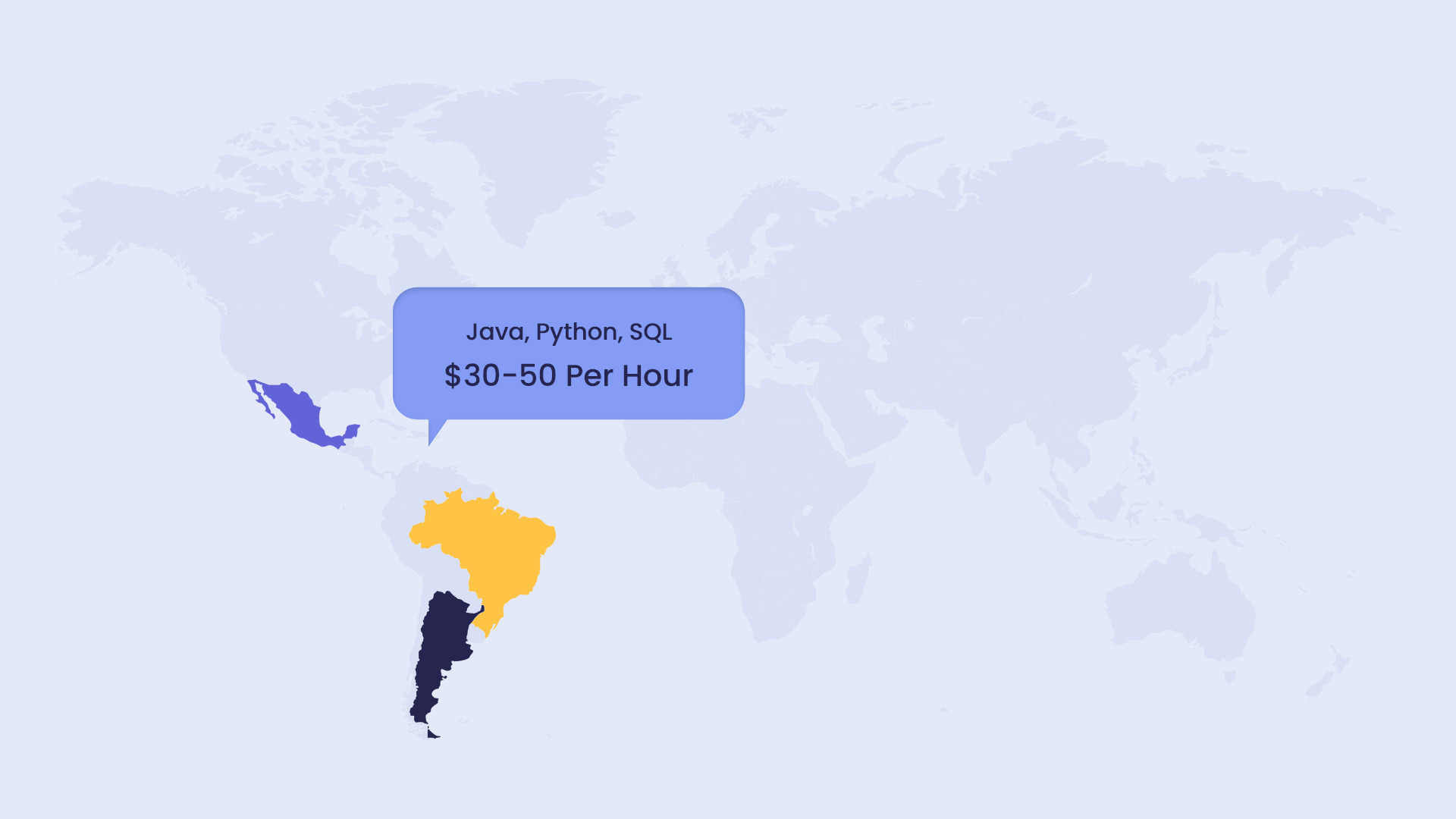
Why Consider Armenia for IT Outsourcing Services
So, why should you choose Armenia for IT outsourcing among all other countries?
Armenia is a country situated between Asia and Europe, combining the best advantages of both outsourcing regions. The country is quickly gaining popularity among companies that need technical professionals. Tech giants such as Cisco, Epam, Microsoft, National Instruments, Oracle, and others have already opened their R&D and software development centers in the region.
The country’s innovator mindset goes over 6000 years back into history. During the times of the Soviet Union, Armenia, which counted only 1.5% of the population, created 30% of all military electronics innovations. Armenians are known for their mathematical minds and strive for innovation.
Today, there are over 450 IT companies and startups in the country. Many of them provide IT outsourcing services to businesses from all over the world. Armenia has become an IT hub with numerous benefits:
- Great price and quality ratio with average costs of $25-$50 per hour
- Highly qualified experts with experience working with machine learning, Big Data, AR, VR, Internet of Things, Artificial Intelligence
- Comparatively low operating costs for IT companies in Armenia
- Free economic zone focused on the IT industry
- Tax benefits for the IT industry
- Great education with a focus on STEM and robotics development
If you decide to outsource to Armenia, how can you find a company for fruitful cooperation?
Clutch is a great place to start. The platform offers a list of the most popular IT outsourcing companies and the services they provide. With over 450 companies, you have a plethora of choices.
If you check Top Add Developers in Armenia or Top Software Developers, you can see a few leaders in the region: Addevice, AIST Global. Develandoo, and Volo. Addevice stands out thanks to the proven track record of working on innovative solutions and expertise in IoT, AR, VR, machine learning, and big data.
Step 8: Shortlist Potential IT Outsourcing Companies
With thousands of IT outsourcing companies worldwide it might be challenging to select just one for your project. That’s why you need to create a list of up to five of the most prominent prospects.
You can start your research at IT directories; Clutch, The Manifest, GoodFirms, etc. You can also go the other way around and ask someone you know for a reference. Word of mouth is a powerful tool when selecting a reliable vendor.
When shortlisting the prospects, pay attention to the following factors:
- What technologies does the company work with?
- What is the ratio of positive vs. negative reviews?
- Is the company among the top IT outsourcing providers in the field?
- Does it have successful case studies with the latest innovations?
Step 9: Identify Top Requirements to Choose the Best Vendor
Now, let’s find out how you can select a vendor for outsourcing. And not just a vendor but the one with the required skillset and expertise. Making the right choice on the first try is essential since we talk about your business and money.
- Background check
Background check is the first stage when searching for a technology partner. You need to learn more about the company you are considering and find the answers to the following questions:
- What does the company specialize in?
- How long has the company been on the market?
- Does it have a proven track record?
- What value can it bring to your business?
- Are there projects in its portfolio that are similar to your one?
- Reviews and references check
Does the company have positive client reviews? You can start the research at Clutch or similar platforms. If there are negative reviews, it should raise a red flag for you. You can go further and reach out to existing and former clients for a reference to make sure that you will sign a cooperation agreement with a reliable company.
In short, here’s what you need to find out:
- Does the company have any relevant experience?
- Does the vendor have any positive reviews?
- Which are the regions of its operation?
- Expertise check
The next step in searching for a company is making sure that it has all the right skills and expertise to meet your business needs. Here is what you need to find out:
- What experts does the company have onboard?
- What technologies does the company work with?
- What services does the company provide?
- Cultural check
Communication is what can bring your project to success or undermine all your efforts at the root. That’s why you need to make sure that no cultural differences will stand in delivering your project. Here are a few questions to take you in the right direction:
- Are there any cultural differences that can become a problem in the future?
- Do the employees speak your language or English?
- Are there any standards in place that manage communication?
- Quality and security check
Quality and security are two factors that can ruin your project if not addressed right. You need to understand how the vendor guarantees the quality of work and how it handles security matters. The following questions will help you get all the correct answers:
- How does the company access code quality?
- Does it have a code review in the established processes?
- Does the team have any industry-recognized certifications?
- What agreements does the company sign with clients?
- How does it ensure its projects meet local regulations and laws?
Step 10: Choose the Best IT Outsourcing Vendor
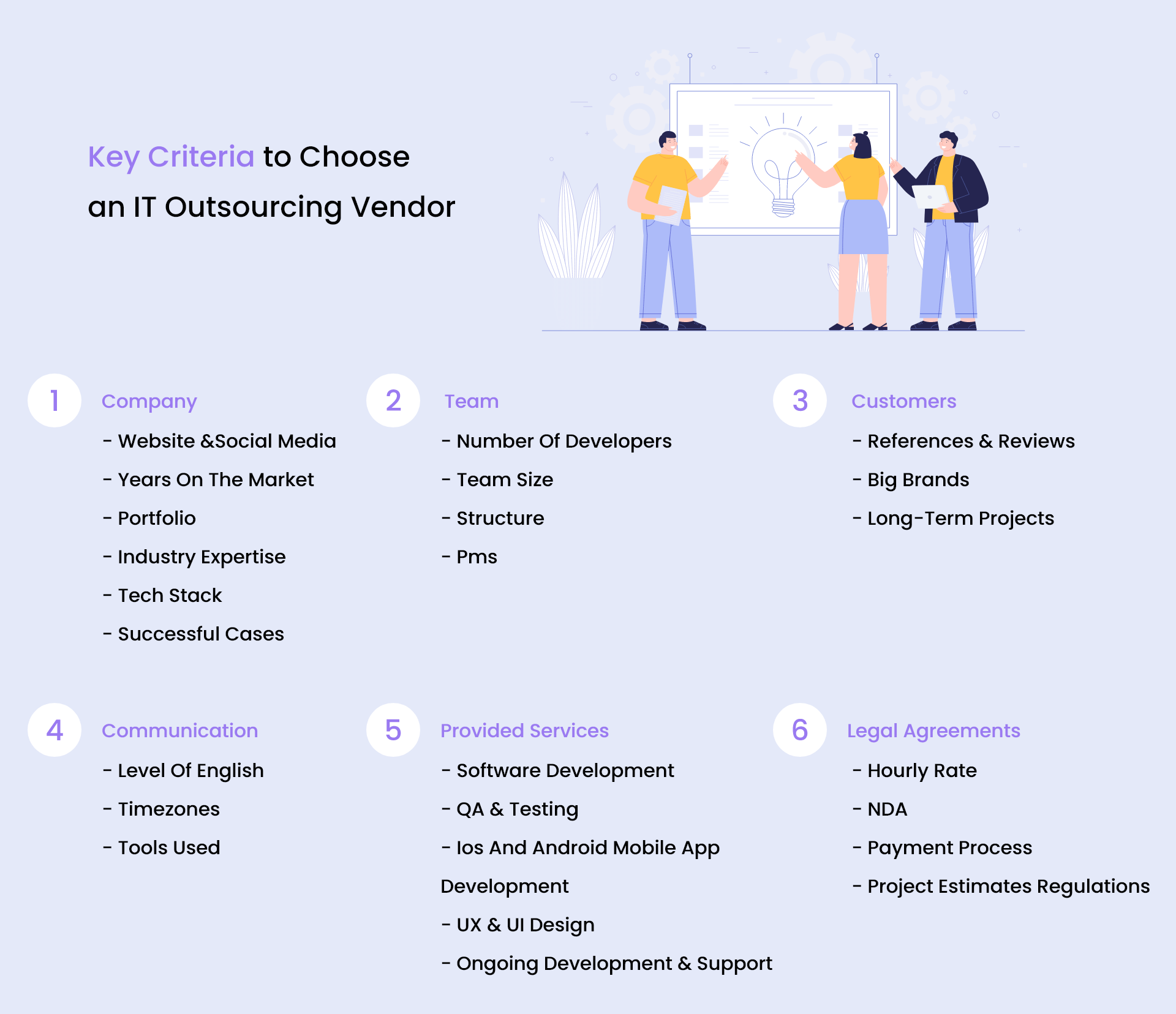
Having followed through the whole process outlined above, you will be able to identify a company best suited to your business needs and requirements. If you’ve done everything right, you will be able to find a vendor that will become your reliable partner for many more years to come.
Information Technology Outsourcing: Bottom Line
Finding a company for your project is not a walk in the park.
You need to understand the differences between key outsourcing regions and which locations offer the best price and quality ratio.
Choose the one with favorable prices, a high level of expertise, and a large talent pool. Don’t forget that communication is the key to successful software development, so choosing a company from a country with the least cultural differences and a high level of English is a safe bet.
Congratulations!
You now know how to choose an IT outsourcing company.
Addevice is a proven leader in software and app development. We work with the latest technologies and have numerous cases where we successfully drive innovations. Reach out to us for a discussion of your idea.
Armenia is a rising star among information technology outsourcing locations. The country is located between Asia and Europe and offers access to highly experienced professionals who work with the latest technologies, such as Machine Learning, Big Data, Artificial Intelligence, VR and AR. With over 450 IT companies in the regions, you get a vast choice.
IT outsourcing offers numerous benefits, such as a better ratio between price and quality, access to a wide talent pool, high scalability, better focus on business strategy, faster hiring process, and less bureaucracy.
- Business analysis
- UX and UI design
- Project management
- Quality assurance
- Front-end and back-end development
- iOS and Android development
- Flutter development
- Software support
Today, you can outsource almost anything, including software development, project management, UX/UI design, business analysis, quality assurance, accounting, marketing, customer services, and many other services.
IT Outsourcing, Outsource App Development, Mobile Application Outsourcing, How to Create a Voice Translation App, Wearable Apps, Create a Restaurant App, Multi Screen Apps, interview, Chatbot Development, Grocery Delivery App, Tools Developer, Mobile Wallet App, Tiktok App, Telemedicine App, Trip Planners, Medical Personnel, Make a Chatbot, IoT App Development, Outsourcing, Mobile App, Workout App, Navigating IT staffing, Staffing industry trends, Navigating IT staffing
Company That Has a Proven Track Record
Navigate the process of selecting the ideal IT outsourcing partner
Our Expertise Includes:
✅ Understanding your project requirements
✅ Evaluating vendor experience and capabilities
✅ Ensuring cultural alignment and communication
Table of contents
FAQ
IT outsourcing is the practice of hiring an external service provider to handle tasks related to information technology, such as software development, mobile app development, support, etc.
There are numerous locations to which you can outsource software development. The key regions include Eastern Europe, Asia, the Middle East, and Latin America. If you need a specific country, Armenia is a great place that combines the quality of provided services with relatively low prices.
Offshoring or offshore outsourcing is a practice of hiring a development company from a distant location. Usually, there is at least a four-hour time difference between your country and your vendor’s country.
Armenia is a rising star among information technology outsourcing locations. The country is located between Asia and Europe and offers access to highly experienced professionals who work with the latest technologies, such as Machine Learning, Big Data, Artificial Intelligence, VR and AR. With over 450 IT companies in the regions, you get a vast choice.
IT outsourcing offers numerous benefits, such as a better ratio between price and quality, access to a wide talent pool, high scalability, better focus on business strategy, faster hiring process, and less bureaucracy.
- Business analysis
- UX and UI design
- Project management
- Quality assurance
- Front-end and back-end development
- iOS and Android development
- Flutter development
- Software support
Today, you can outsource almost anything, including software development, project management, UX/UI design, business analysis, quality assurance, accounting, marketing, customer services, and many other services.
 The Growth of Addevice in an Interview With Grigory Jlavyan
The Growth of Addevice in an Interview With Grigory Jlavyan
 How to Make Your Mobile App a Flourishing Business in 2024
How to Make Your Mobile App a Flourishing Business in 2024
 Addevice in the top mobile development companies
Addevice in the top mobile development companies